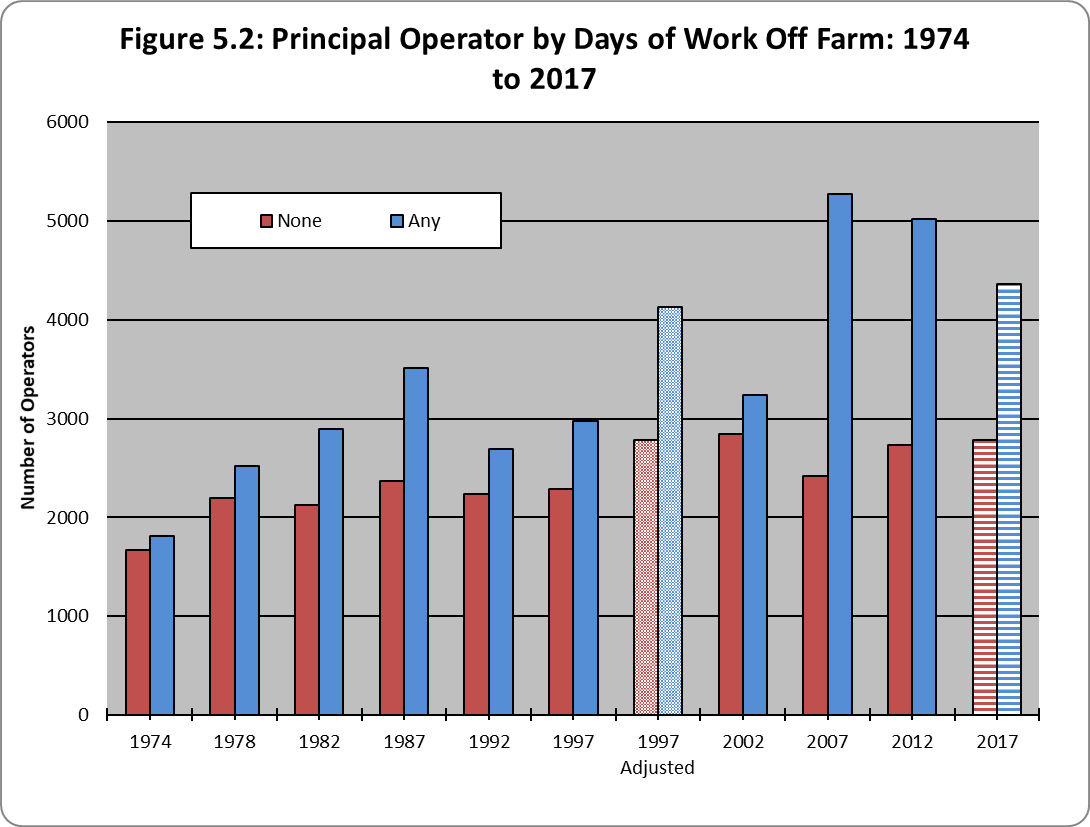Full and Part-time Farming
Massachusetts Agricultural Census 2017
Figure 5.2 shows the number of principal farm operators/ producers for the Agricultural Census years. The bars labeled “None” represent the operators who did not work off the farm. The number of operators with no off-farm work has remained fairly stable over time, increasing in the late 70s, again in the late 90s before dipping a bit in 2007. Historically, Massachusetts has had about 2,400 full-time farm operators. In 2012, there were 2,736 farm operators with no off-farm work, just about 100 operators under the greatest number recorded in the 2002 Census (2,841). Thus, while the decade suggests some variation in numbers of full-time farmers, we have seen a relatively stable population of full-time farm operators averaging about 42 percent of all principal farm operators.
The population of part-time farm operators is much more variable, being affected more by local economic conditions and relative farm prices. The numbers of part-time farmers have accounted for more than half of all principal farm operators/ producers in all census years, and are an essential part of the Massachusetts farm population. With a few exceptions, the relative proportion of part-time farmers has grown in Massachusetts. In 1978, there were about 2,200 full-time farmers and 2,500 part-time farmers. The greatest difference occurred in 2007 when there were about 2,400 full-time farmers and nearly 5,300 part-time farmers. In 2012, full-time farmers grew to 2,736 from the 2007 level and part-time farmers dropped to 5,019, about 65 percent of the total number of principal farm operators. On average, part-time farmers have represented about 58 percent of principal farm operators. Due to that changes in the definition of the primary farm operator/ producer, results for 2017 are difficult to interpret. Future census years will allow a more nuanced interpretation of whether the decrease seen is a result of the change in definition of principal/ primary or a change in number of operators who work off farm.

Figure 5.3 shows the distribution of part-time farmers by the number of days they worked off the farm, “Less than 200 Days” and “200 Days or More.” On average in 2017, about 60 percent of the principal operators/ producers who worked off-farm worked 200 days or more off the farm. This proportion has been erlatively stable over time, with a previous low of 61.2 percent (2012) and a high of 66.8 percent (2002). Trends in farm operator off-farm work reflect the strength of the economy, and off-farm opportunities. As economic conditions decline, off-farm opportunities for farm operators also decline. Unemployment in Massachusetts exceeded 8 percent in 1992, but was back down around 4 percent in 1997. In 2002, unemployment climbed a bit above 5 percent, and was back to around 4.5 percent in 2007. Farm operators balanced employment opportunities off the farm with returns from working on the farm, essentially managing a portfolio of labor options. Again, future census years will allow a more nuanced interpretation of the decrease in operators'/ producers' days worked off-farm.

